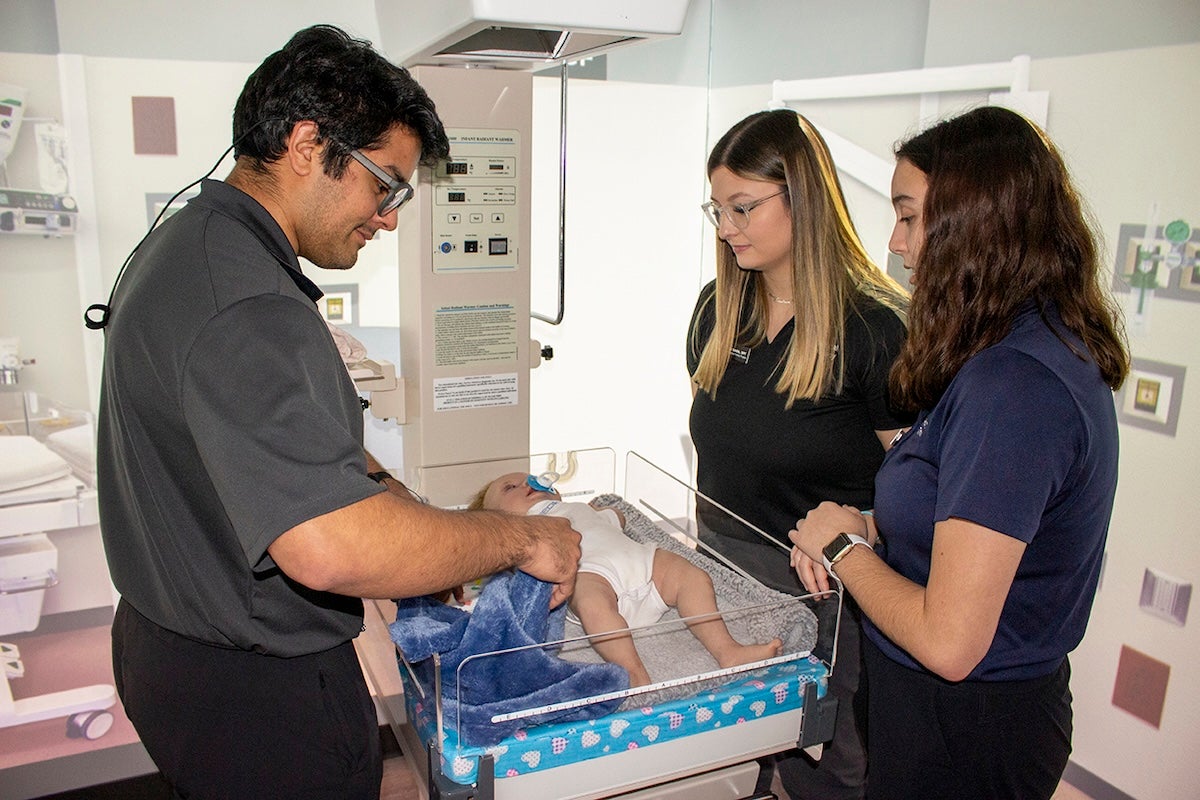Students at the College of Health Professions and Sciences (CHPS) are learning how to succeed on a healthcare team through immersive clinical experiences that enable them to develop skills in the delicate and high-stress environment of a simulated neonatal intensive care unit (NICU).
This week is Healthcare Simulation Week and September is NICU Awareness Month.
As medicine advances and increases the survivability of pre-term infants, clinical skills in a NICU setting become even more vital for students to possess. However, training in a NICU has become increasingly difficult to access following the COVID-19 pandemic and the concerns presented by the presence of other infectious diseases like RSV and the flu, which limit opportunities for students to gain hands-on learning in critical care environments prior to entering the profession.
Students in CHPS now interact with hyper-realistic baby manikins in the Blended Learning Interactive Simulation Suite, or BLISS, a high-tech immersive space that can incorporate the sights and sounds of an intensive care setting. The suite adds a layer of complexity and realism and exposes students to the stressors of the NICU, emulating what students will see in their clinical and professional roles. While in the suite, students practice therapeutic handling skills and neonatal positioning for feeding and swallowing, behavioral assessments and vital sign monitoring. The manikins simulate newborn behaviors like crying, suctioning, breathing sounds and even seizures. Two isolettes and a warmer are also incorporated into the instruction.
Funded in part by a philanthropic gift from the Paul B. Hunter and Constance D. Hunter Charitable Foundation, the enhanced simulation instruction is expected to bolster students’ comfort and confidence in a NICU setting.
Students studying physical therapy, communication sciences and disorders and social work have the opportunity to work together in the unique training sessions. Leaders hope to also incorporate students from medicine and nursing in the future.
“It gives students an appreciation for the complexity of the environment and provides the implications for growth and development,” says Jennifer Tucker, clinical associate professor of physical therapy, who used the manikins in her physical therapy classes last fall. “Chances are they will treat a child that came from the NICU during their career.”
After working in BLISS, students use the center’s holoportation technology to meet parents who’ve had a child in a NICU and learn more about developmental impacts and the concerns of parents and caregivers.
“In most cases, families are not expecting their child to be admitted to the NICU,” says Bari Hoffman, associate dean of clinical affairs. “So, when this happens, intense feelings of concern and worry follow suit, making it even more imperative that healthcare providers project competence and experience.”
The center’s immersive simulation technology, in tandem with the manikins, offers students a unique opportunity to develop, refine and strengthen their clinical skills in a forgiving environment. They’ll be able to better understand the complexity of such young patients, considerations with their airways and mobility, and a stronger understanding of how to care for preterm infants and support their families.
“We’re combining tangible and immersive component s, and this opportunity allows us to train our students in environments they otherwise have limited to no access to,” Hoffman says. “The highest level of realism for students represents their transition to practice and workforce readiness. We are thinking differently about how we train the next generation of healthcare providers, particularly in specialty skills and complex high-risk scenarios.”




